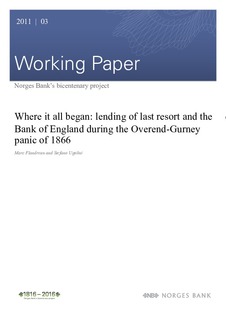| dc.contributor.author | Flandreau, Marc | |
| dc.contributor.author | Ugolini, Stefano | |
| dc.date.accessioned | 2018-05-03T11:02:46Z | |
| dc.date.available | 2018-05-03T11:02:46Z | |
| dc.date.issued | 2011 | |
| dc.identifier.isbn | 978-82-7553-599-1 | |
| dc.identifier.issn | 1502-8143 | |
| dc.identifier.uri | http://hdl.handle.net/11250/2496960 | |
| dc.description.abstract | The National Monetary Commission was deeply concerned with importing best practice. One important focus was the connection between the money market and international trade. It was said that Britain’s lead in the market for “acceptances” originating in international trade was the basis of its sterling predominance. In this article, we use a so-far unexplored source to document the portfolio of bills that was brought up to the Bank of England for discount and study the behavior of the Bank of England during the crisis of 1866 (the so-called Overend-Gurney panic) when the Bank began adopting lending of last resort policies (Bignon, Flandreau and Ugolini 2011). We compare 1865 (a “normal” year) to 1866. Important findings include: (a) the statistical predominance of foreign bills in the material brought to the Bank of England; (b) the correlation between the geography of bills and British trade patterns; (c) a marked contrast between normal times lending and crisis lending in that main financial intermediaries and the “shadow banking system” only showed up at the Bank’s window during crises; (d) the importance of money market investors (bills brokers) as chief conduit of liquidity provision in crisis; (e) the importance of Bank of England’s supervisory policies in ensuring lending-of-last-resort operations without enhancing moral hazard. An implication of our findings is that Bank of England’s ability to control moral hazard for financial intermediaries involved in acceptances was another reason for the rise of sterling as an international currency. | nb_NO |
| dc.language.iso | eng | nb_NO |
| dc.publisher | Norges Bank | nb_NO |
| dc.relation.ispartofseries | Working Papers;3/2011 | |
| dc.rights | Attribution-NonCommercial-NoDerivatives 4.0 Internasjonal | * |
| dc.rights.uri | http://creativecommons.org/licenses/by-nc-nd/4.0/deed.no | * |
| dc.subject | JEL: E42 | nb_NO |
| dc.subject | JEL: E58 | nb_NO |
| dc.subject | JEL: N13 | nb_NO |
| dc.subject | financial crisis | nb_NO |
| dc.subject | lending of last resort | nb_NO |
| dc.subject | history of monetary policy | nb_NO |
| dc.subject | shadow banking system | nb_NO |
| dc.subject | banking supervision | nb_NO |
| dc.title | Where It All Began: Lending of Last Resort and the Bank of England During the Overend-Gurney Panic of 1866 | nb_NO |
| dc.type | Working paper | nb_NO |
| dc.description.version | publishedVersion | nb_NO |
| dc.subject.nsi | VDP::Samfunnsvitenskap: 200::Økonomi: 210::Samfunnsøkonomi: 212 | nb_NO |
| dc.source.pagenumber | 45 | nb_NO |
| dc.relation.project | Bicentenary Project | nb_NO |
| dc.relation.project | Tohundreårsjubileum | nb_NO |

